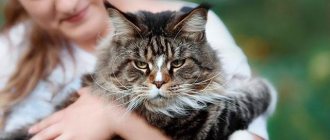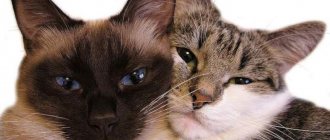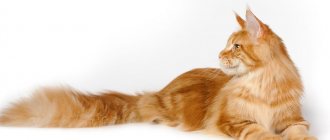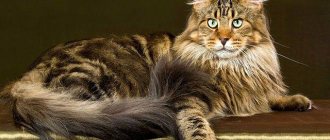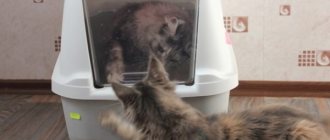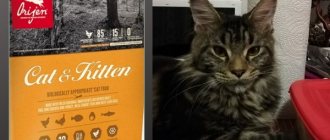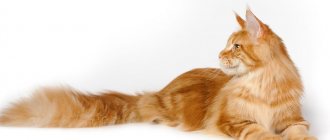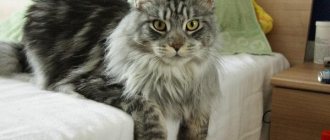15296Marina Kharlova
Maine Coon and an ordinary cat have many differences, however, the market is filled with a huge number of kittens that are passed off as real purebreds. In fact, at best it will turn out to be a mestizo - a cross between a Maine Coon and an ordinary cat, or it will even turn out that the Maine Coon was not even close to that.
In order not to make a mistake in choosing, you need to clearly know the characteristics characteristic of this breed. Before you go for the long-awaited kitten, it is worth studying in advance how the Maine Coon and an ordinary cat differ.
The handsome Maine Coons, with their appearance and large size, are more reminiscent of a real wild animal than a pet, due to which the demand for representatives of the breed has been steadily growing in the last decade.
© shutterstock
How to distinguish a Maine Coon by external data
Without practical experience, it is difficult to distinguish a purebred cat from a Maine Coon mestizo, so it is better to seek help from a specialist who knows the little-known nuances of the breed. But there are a number of obvious signs for comparing kittens with and without pedigree.
These include the length and color of the coat, eye color, size, weight of the baby and other developmental features of the animal.
Important! The best time to visit the nursery and choose a Maine Coon is 2 to 3 months after birth. At this age, the distinctive characteristics of the breed are already obvious.
By length, quality and color of coat
A Maine Coon kitten's fur is soft and pleasant to the touch. There are no adult attributes in the form of a fluffy mane and panties on the hind legs yet, but even in childhood, the cover on these parts of the body is more pronounced than in ordinary cats.
It is also possible to determine whether a Maine Coon is a real Maine Coon or not by the color of a kitten’s fur at a young age. Colors unacceptable for these animals: chocolate and cinnamon (cinnamon), rich lilac colors and lightened shade of coastal sea sand (fawn).
This breed does not have color-point or acromelanic colors.
By weight and size
The next distinguishing feature is the difference in weight and size of an ordinary cat and a purebred Maine Coon.
| Boys (kg) | Girls (kg) | |
| Birth | 0,12-0,16 | 0,1-0,14 |
| 1 month | 0,65-0,75 | 0,55-0,7 |
| 2 months | 1,2-1,5 | 1-1,4 |
| 3 months | 2,8-3,7 | 1,6-2,4 |
| 4 months | 3,1-3,9 | 2,5-3,6 |
| 5 months | 3,3-4,2 | 2,8-4 |
* Information about weight depends on the breeding qualities of the parents and the number of kittens in the litter.
By the age of three months, the body weight of an ordinary cat, in comparison with a Maine Coon, is approximately 2 times less.
Important! There is a universal formula for determining the weight of a Maine Coon - its age in months, multiplied by a factor of 0.5. Under any conditions, the kitten cannot be lighter than the resulting number (kg).
By physique
The following characteristics will help determine the characteristics of the breed characteristics of Maine Coon kittens by constitution (structure):
- The body is long, elongated, rectangular in shape, the front and hind limbs are of the same height.
- The paws (especially the front ones) are powerful and straight.
- The long, even tail reaches the shoulder blades.
According to general indicators, a Maine Coon next to an ordinary cat of the same age looks like Gulliver in the land of Lilliput.
If you have doubts about the purebred kitten, you need to pay attention to the animal’s head - a real Maine Coon has the following external signs:
- The ears are large, located almost vertically, with a slight tilt forward.
- Box-shaped muzzle with high cheekbones.
- In profile, a “hall” is clearly visible between the bridge of the nose and the forehead, which can be formed with varying degrees of bending.
By the eyes
The Maine Coon's eyes are large and slanted. There are no specific requirements for the color of the iris - it can be green, amber, golden, blue, even heterochromia (eyes of different colors) is allowed.
By growth and development rate
At three months of age, you can easily distinguish a Maine Coon by its size - it will be 2 times larger than a regular cat. By 6 months, the cat will be the same size and weight as a normal adult cat.
If we are talking about mestizos, then the problem becomes more complicated. Depending on the parental qualities inherited, such cats sometimes grow as actively as their purebred relatives.
Important! It is almost impossible to distinguish a Maine Coon kitten from a mestizo (mix of breeds) at one month of age.
Breed Features
You can recognize a Maine Coon by its size. Next to the yard cat, the coon looks larger. Representatives of this breed can be identified by the shape of their eyes: they are slanted, while in an ordinary cat they are round. Another notable difference is the bushy tail and “tassels” on the tips of the ears, with which small kittens are born.
A true Maine Coon differs from other cat breeds in its high level of intelligence. Thanks to this feature, this breed is easy to train.
How to recognize a real Maine Coon?
- The cats have a strong build (up to 1 meter in length) with a massive skeleton and large limbs. In this case, the weight reaches 10-11 kilograms.
- Large, high-set ears, on the inside of which hair grows, similar to a brush.
- The muzzle is square in shape.
- Fluffy tail and mane.
- Long hair on the legs, belly and chest. It is shorter on other parts of the body.
Maine Coons are peaceful and active animals that communicate well with all family members.
Coons are peace-loving, friendly and non-conflict representatives of the cat breed. The owner for them is one person whom the cat chooses himself. Does not express aggression towards other family members. These are mobile and active cats who are interested in everything that happens around them. In addition, they love to talk, which is expressed in the form of low, soft purrs or purrs.
Additional characteristics of the Maine Coon breed
Additional external signs of a true Maine Coon include tufts on the ears, the presence of hair between the toes and a luxurious tail. If a kitten's tassels have not grown at 2-3 months of age, they will no longer exist. But this does not discard him from breeding and does not close the way to diplomas at exhibitions.
Friendliness and sociability
An adult Maine Coon is truly responsive, friendly and attached to its owner. But this is not a unique sign that indicates the “purity” of the breed.
Love for water
Unlike ordinary cats, Maine Coons love water. They swim without being forced and at the same time snort contentedly, which shows their owner their pleasure. If a pet is afraid of water, it probably has a mixture of other breeds in its genes.
How old do Maine Coons grow?
Once a Maine Coon turns one year old, weight gain gradually slows down. However, the muscles and bones are not completely formed by the first mating in males or the birth of females, as happens in other breeds. Weight gain in the breed continues up to 3 and even 4 years, especially in males. In American-type coons, maturation is even later - up to 5 years.
If a cat is untied at one year old, then he still remains a kitten by Maine Coon standards. At the same time, many owners have a concern: if they untie their pet early (before 2 years), it will stop growing. Veterinarians and breeders consider this judgment to be incorrect.
From 8 months to 1.5 years is considered the optimal age for untying a male.
If the first mating occurs after 2 years, then there are many cases of failure due to the cat’s lack of experience.
Comparison of Maine Coon and regular cat
If the kitten is not met in a nursery, and there is no opportunity to see its parents, you need to pay attention to the following signs:
- The muzzle - in an ordinary cat it is pointed, but in a Maine Coon the lower jaw and chin meet at an angle of 90°. The front part has the same geometry – from the nose to the chin.
- Mustache. Everything is simple here - the long and hard whiskers of a Maine Coon cannot be confused with the thin whiskers of an ordinary cat.
- The luxurious tail extends approximately ¾ of the length of his body and will be 2 times longer than that of a purebred cat.
What influences development
The development of a purebred pet is influenced by the following factors:
- Floor; girls are usually born smaller in size than male maikunas; Adult cats are also different; they weigh less.
- Number of babies in the litter; most often 4-5 individuals are born. If a cat has 6-7 kittens, each weighs about 100-120 g;
- Parameters of the mother and her nutrition during pregnancy. Food rich in proteins, fats, vitamins and beneficial microelements will support the cat’s health and provide the baby’s body with the necessary substances;
- Conditions of detention; a clean, healthy, vaccinated and treated animal for ticks, fleas and worms is stronger than its unkempt counterparts;
- Selection work of the breeder; affects the formation of the skeleton and skull of the pet.
- Stressful condition in a cat. The composition of mother's milk in an unfavorable situation deteriorates, this affects the growth of babies.
How to distinguish a Maine Coon kitten from a regular one
It is not difficult to see the differences between an older Maine Coon and an ordinary cat of the same age, even if the latter had purebred ancestors and is similar in appearance to them.
- The Maine Coon can and loves to stand on its hind legs. In this position, he freezes for a long time in front of the TV or at the windowsill.
- You can’t force an ordinary cat to carry something in its teeth on command, but a Maine Coon will bring you slippers and run for a stick.
- Communication skills. Loneliness is more likely the lot of ordinary cats, but not the Maine Coon.
One of the described qualities can manifest itself in all cats, regardless of breed. But in combination they are characteristic only of the Maine Coon.
Kitten development from inception to adulthood
A newborn Maine Coon kitten is much larger than its counterparts of other types of cats. The approximate weight of a baby of this breed is 130-160 grams , while kittens of other breeds (even quite large ones, for example, Persians or Sphynxes) weigh no more than 120 grams.
Maine Coon breeders believe that the weight of a kitten depends on the number of kittens born in one litter - the fewer kittens, the larger they are.
However, no less important factors in the development of the exterior and muscle growth of a healthy kitten are its decent living conditions and proper nutrition. Even a very large kitten can be stunted if all the required favorable conditions for caring for its nursing mother and directly for it are not met.
It happens that the growth of a kitten is significantly influenced by the genetic predisposition to marriage of the breed. However, a person is in no way able to correct this disposition.
But, as a rule, the dynamics of a kitten’s constitutional and muscular development still depend on its initial mass . Most often, it is this factor that directly affects the growth rate of the kitten. But one more very important point must be taken into account - his gender. For example, females develop physically much more slowly than males. Differences in size can already be seen in kittens of different sexes at 3 months.
As surprising as this may sound, the weight of a kitten may also depend indirectly on the weight of the mother. The environment, the composition of the diet, lifestyle - all this can affect the well-being of the mother cat, accordingly, the synthesis of immune cells and the production of high-quality milk for breastfeeding.
At the same time, a nursing cat should not abuse hormonal drugs during the treatment of some diseases, avoid stressful situations, since all this can affect the benefits and properties of milk, as well as the general health of the animal. Naturally, treatment with hormonal drugs is not allowed for Maine Coon kittens, since their use disrupts the normalization of sexual development and metabolism.
A pregnant cat should be fed with balanced food and in doses, without overfeeding. Food must contain a minimum amount of chemicals and a large amount of proteins. The cat needs to be provided with access to fresh cat water.
You should not restrict the movement of a pregnant cat, or leave her in the cold for a long time, otherwise the animal can become hypothermic, and this will certainly affect the health of her unborn kittens.
The weight gain of a newborn Maine Coon kitten during its natural growth should be at least 10 grams per day . A delay in weight gain is possible only at a very early age, and even then, the stop should not be more than two days. When a kitten's growth is delayed for more than 2 days, the animal needs to be shown to a veterinarian to determine the real cause of the failure.
When only one kitten out of many is underweight, it is necessary to monitor breastfeeding of the entire litter. Probably the stronger kittens do not allow the weaker ones to feed.
After one month of life, a healthy kitten should weigh between 600-800 grams . During the 5th week, weight gain may decrease significantly. The transitional age for Maine Coon kittens lasts approximately 1-2 months, so the stability of weight gain quite often balances (especially when the kittens are switched to dry feeding).
Starting from the second month and then progressively (up to approximately 3 years in males, in females, probably a little earlier), the weight of kittens steadily begins to increase. In about a week, a young body gains 190-220 grams per month. (cats), 210-250 gr. - cats.
Kittens must gain weight gradually. Do not, under any circumstances, strive to increase the animal’s weight to 12 kg by the age of one year! Do not forget that the Maine Coon’s body develops up to three years, the constitution and muscles of the animal must develop proportionally. When a cat gains significant weight at one year of age, it is most likely obese. There is no need to neglect your cat's health for the sake of setting records.
Unhealthy weight gain can have a significant impact on your Maine Coon's health:
- The cat will be lazy, slow, and less active.
- Problems with blood vessels, heart and liver will appear.
- When running fast, an animal may experience groaning and shortness of breath.
This should not be allowed, since nature has endowed these amazing cats with a truly playful, cheerful and lively character. They are sympathetic, kind, brave and sociable. Most often, poor health occurs due to improperly selected content and diet.
In some cases, with poor nutrition, animals of this breed may have a strong bad breath, this indicates intensive growth of bacteria in the stomach or disease of the teeth and gums.
What else to pay attention to
There are additional ways to protect yourself from purchasing an ordinary cat disguised as a purebred Maine Coon. They relate not to the appearance and characteristics of the kitten itself, but to the conditions of its sale and execution of the transaction.
An experienced breeder will not place a kitten under 3 months of age into the wrong hands. By this period, all vaccinations and treatment against parasites must be completed. At this age, the pet is already completely ready for socialization.
A purebred Maine Coon, unlike an ordinary cat or mixed breed, must have documents confirming the breed.
In them, experts describe the advantages of a cat and place it in one of three groups:
- The highest level is the Show class, which implies exhibition qualities and value for breeding.
- Breed group with good genetic characteristics and prospects for breeding work.
- Pet cats. Maine Coons fall into this category, the owners of which do not intend to go to exhibitions and raise kittens.
The Maine Coon is a huge fluffy cat with tufted ears, a long fluffy tail and powerful paws. It is impossible to confuse it during adulthood with another breed. But in childhood, all kittens seem the same, and their spontaneous purchase often turns into a regular lottery. Therefore, the main guarantee that your pet belongs to a certain breed will be the presence of a pedigree.
Maintenance and care
Artificial ways to grow, enlarge, make tassels more voluminous:
- Correction of the amount of hair on the upper tip of the ear;
- Periodic thinning, coinciding with molting;
- Gentle hair treatment with medicinal ointments and oils.
Timely, regular examination of the cat, necessary vaccinations, provision of a vitamin complex to maintain immunity, protection from parasites and infections are the key to good health of the pet and, accordingly, lush, beautiful hair tails. Combing the fur every 1-2 days prevents the formation of lumps and reduces the amount of hair eaten by the cat when licking. Knowledgeable breeders recommend bathing Maine Coons once a month or as needed. The process is turned into a fun game, rewarding the animal with tasty treats for good behavior.
Comparison with mestizo
The most difficult task is to distinguish a purebred Maine Coon from a mixed breed. Felinologists call the clear geometry of the muzzle the main distinguishing feature: in a purebred individual, the muzzle is a perfect box formed by whisker pads. Mestizos are most often smaller than purebred animals. If an adult weighs no more than six to seven kilograms, then it is most likely a crossbreed. Surely a specialist will help you figure out whether the animal is purebred or not. You can also analyze your pedigree for crossbreeding with non-purebred cats. Mixed breeds, moreover, are usually cheaper than highly purebred pets.
Maximum weight and size
A person who cares about the health of his baby should be interested in information about how much a Maine Coon weighs. On average, spayed and neutered pets are significantly larger than other representatives of the breed. Dimensions: Maine Coon cat weight up to 8 kg, boys - up to 12 kg. The height at the withers of the pets reaches 33-34 cm. The length of the tail is about 35-35 cm and more. The maximum actual weight of the animal is 15 kg.
The longest Maine Coon cat is listed in the Guinness Book of Records. Its length was 123 cm, weight - 14 kg, tail size - 41.5 cm. The cat's name was Stewie, he lived in Nevada. The record is considered unbeaten.
In Finland there is a 16-kilogram cat that has grown to 1m20cm. The owner of the furry pet assures that he monitors the “baby’s” nutrition, does not overfeed him, and takes care of the physical activity of his ward. Information about 25-kilogram individuals of the breed is not true.
Girls weight
The sizes of newborn babies differ little. Adult girls range from 3.5 to 5.5 kg. They are usually 2-3 kg lighter than males.
Boys weight
Normally, animals allowed for breeding weigh from 6 to 8.2 kg. Males are larger and heavier than charming cats. After castration, cats gain even more volume.
Conclusion
Owners of Maine Coon cats need to take care of the active life of their pupil. Representatives of the breed are considered excellent hunters; moving an object will arouse genuine interest and delight in them. In pet stores you can purchase items to entertain your furry animal:
- various tunnels;
- balls;
- figures on a spring;
- clockwork mice.
The animal will not only switch its attention from the furniture in the apartment to outdoor games, but will develop its muscles.
The pet will respond with affection and attention for your care. There are cases when Maina pets came running to children at night, lay down next to them, and the child fell asleep.
At any age and any size, a cat remains a devoted friend. He willingly lends himself to education and training: he can bring an abandoned toy or offer his paw for food. For their dexterity and skills, menicoons are compared to dogs. Despite this circumstance, the animal should not be allowed to roam freely. In a dangerous situation, the pet will not fight back.
Exterior of an adult cat
- foldable, muscular body and powerful chest;
- long bulky paws with hair between the claws;
- a large and fluffy tail that reaches to the shoulder blades of Maine Coon cats, and sometimes to the neck;
- long mustache;
- eyes large, oblong;
- the ears are large, set high, with large tufts;
- the gap between the ears is equal to the width of 1 ear;
- the head is shaped like a square, and the lower part of the muzzle with a mustache and chin is called a “box”;
- a well-developed chin that is in line with the nose;
- smooth and thick hair, varying in length on different parts of the body;
- the hair on the chest creates a fluffy collar, a “spectacular mane”;
- All colors are recognized except chocolate and color point.
